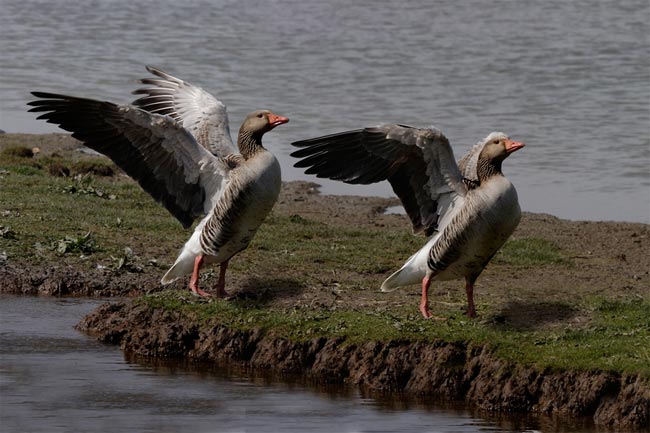Why It's OK for Birds to Be Gay

In greylag geese, nearly a fifth of all long-term couples are composed of two males. They're not alone: More than 130 bird species are known to engage in homosexual behavior at least occasionally, a fact that has puzzled scientists.
After all, in evolutionary terms same-sex mating seems to reduce the birds' chances of reproductive success. But that's not necessarily so, according to a new study. In a given species, the sex with lighter parental duties tends to mate more, period — whether with the same or the opposite sex.
Birds engage in all kinds of same-sex hanky panky, from elaborate courtship displays to mounting and genital contact to setting up house together. In some species the same-sex pairs even raise young (conceived with outside partners, obviously) and stay together for several years.
In 2007, a team led by Geoff MacFarlane, a biologist at the University of Newcastle in Australia, reported that male homosexual behavior was more common in polygynous bird species, where males mate with numerous females, and that female homosexual behavior was more common in monogamous species.
Intrigued, MacFarlane looked for help explaining the pattern in a theory predicting that whichever gender spends less time caring for young tends to have sex with more partners.
Scoring sex
To find out whether the theory might extend to homosexual behavior, MacFarlane and his team exhaustively combed the literature for accounts of same-sex courtship, mounting, or pair bonding. They focused on the 93 bird species whose homosexual interactions scientists had seen in the wild. For each species, the team calculated the frequency of homosexual behavior as well as both sexes' contributions to parenting.
Sign up for the Live Science daily newsletter now
Get the world’s most fascinating discoveries delivered straight to your inbox.
Overall, homosexual behavior amounted to less than 5 percent of all sexual activity in the 93 species, though in some cases it was much higher. And sure enough, there was a strong correlation between a species' mating system and its homosexual behavior. Whichever sex did less parenting also typically did more same-sex canoodling – basically because they could. This tended to be true for the promiscuous males in polygynous species. The balance shifted to females in socially monogamous species, where the sexes split the work more equitably.
So far, female homosexuality hasn't turned up in the handful of birds where each female mates with many males, but MacFarlane's team predicts it may.
Evolutionary outcomes
The unburdened sex is free to take advantage of whatever mating opportunities come their way, MacFarlane explained. "Homosexual behavior is more likely to be maintained and not be selected against than if you are a sex that cares a lot for offspring and only has one or few reproductive partners," he said.
And with plenty of reproductive prospects, a little homosexual behavior won't have much effect on long-term reproductive success, MacFarlane said. "That's quite different to what the traditional argument is in the literature, where homosexual behavior is seen as a cost."
In some cases, homosexual alliances may even be adaptive, helping individuals defend territories, advance their social status, or get help with parental care.
MacFarlane's team is now investigating whether primates exhibit patterns like the one they've found in birds.
Their paper is being published in a forthcoming issue of the journal Animal Behavior.









